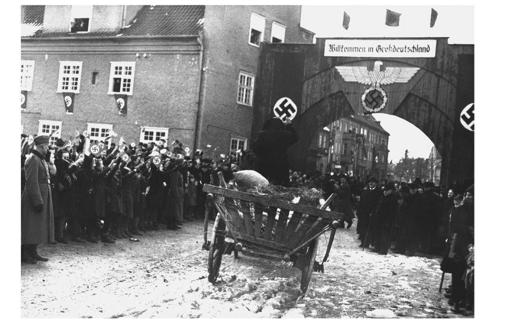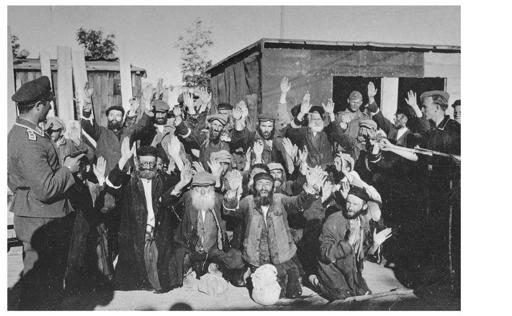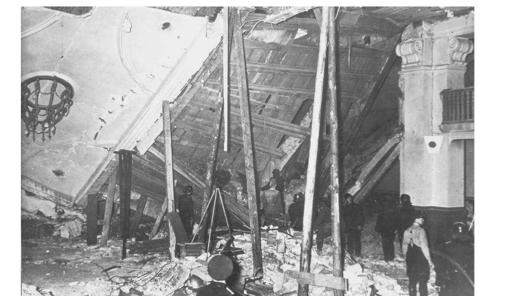The Third Reich at War (168 page)

Weichs, General Maximilian
Weill, Kurt
Weimar Republic
far right
violence of early years
Party leaders evade legal responsibility
army generals hope for downfall
unpolitical army claim
‘White Rose’ youth movement and
party-political animosities
crises of
Weinrich, Karl
Weiss, Wilhelm
Weissensee
Weizs̈cker, Ernst von
Welfare organization, National Socialist
‘Werewolf’ (Hitler’s field HQ)
‘Werewolf’ (partisan movement)
Werner, Kurt
West Germany (German Federal Republic)
West Prussia
West Wall
Westerbork transit camp
Wewelsburg
Weygand, Maxime
White Dream, The
(film)
‘White Rose’ resistance movement
Widmann, Albert
Wieloncza
Wienken, Heinrich
Wiesbaden
Wiesenthal, Simon
Wilhelm Gustloff
(cruise liner)
Wilhelm Gustloff Foundation
Wilhelmina, Queen of the Netherlands
Willrich, Wolfgang
Wilm, Ernst
‘Window’ (anti-radar device)
Windsor, Duke and Duchess of
winter clothes for troops campaign
‘Winter War’ 1940 (Soviet Union/Finland)
Wirth, Christian
Wise Woman, The
(
Die Kluge
; Orff)
Wisliceny, Dieter
Witebsk
Witten
Witzleben, General Erwin von
Ẅhler, Otto
Wolff-Metternich, Count Franz
Wolff-M̈nckeberg, Mathilde
wolframite
‘Wolf’s Lair’
Wolfsburg
Woman in the Moon, The
(film)
women
League of German Girls
‘civilizing mission’ of German women in occupied Poland
Nazi women’s organizations
rape
in Ravensbr̈ck concentration camp
included in massacres of Jews east
in ghettos
in extermination camps
in Auschwitz
foreign workers
in workforce
propaganda on women’s roles
and evacuation schemes
prison population
killing of Gypsy women
wartime married life
sexual morality
in higher education
medical experimentation on
in resistance movements
declining morale on home front
conscription
‘wonder-weapons’ ;
see also
;
‘Word of the Week’ (poster)
working classes
enrolled as members of ‘master race’
victims of bombing raids
evacuees
and resistance movements
Woyrsch, Udo von
Wren, Sir Christopher
Wronki prison
Wuppertal
Wurm, Theophil, Bishop of Ẅrttemberg
Ẅrttemberg
Ẅrzburg
Ẅrzburg University
x-rays
Yalta
Yasnaya Polyana
Yiddish
Yorck von Wartenburg, Peter
York
Yugoslavia
German invasion
partition
collapse of postwar state
atrocities against Jews
partisans
copper mines
resistance
withdrawal of German forces
see also
Croats, Croatia; Serbs, Serbia
Zakopane
Zamboni, Guelfo
Zamość
Zawada
Zeitzler, Kurt
Zempelburg
Zervas, Napoleon
Zhukov, Georgi
zinc
Zion, The Protocols of the Elders of
Zionists
Zlocz’w
Zurich
Zweig, Stefan
Zyklon-B (poison gas)

I. The German Army enters Lódz in September 1939 to an ecstatic welcome from ethnic Germans, while the city’s Polish inhabitants look silently on.

2. Redrawing the racial map of Europe: ethnic Germans from Lithuania cross the border with Germany at Eydtkau in East Prussia in February 1941, entering the Reich under a banner bidding them ‘Welcome to Greater Germany’.

3. Polish Jews are assembled for road-sweeping duties by German troops, September 1939.

4. German air force troops round up a group of terrified Jews in the diarist Zygmunt Klukowski’s home town of Szczebrzeszyn.

5. This still from I Accuse (1941), directed by Wolfgang Liebeneiner, shows the concert pianist Hanna Heyt, who is suffering from multiple sclerosis, asking her friend Dr Lang for advice; his opposition to assisted suicide is used as a foil for the film’s justification of the killing of the incurably ill.

6. An assassination attempt that failed: the destruction caused in a Munich beer-cellar on the evening of 8 November 1939 by a bomb planted by the lone left-winger Georg Elser. Hitler left the hall shortly before the bomb went off.

7. Rudolf Hess visits the Krupp armaments factory on I May 1940, flanked by Robert Ley (left) and Alfred Krupp (right).

8. ‘The biggest traffic jam in history’: German armour squeezes through the narrow gorges of the Ardennes on its way to France on 11 May 1940.

9. Hitler, with Albert Speer (left) and Arno Breker (right), at the Trocadéro in Paris during a brief private visit to the conquered city on 28 June 1940.
